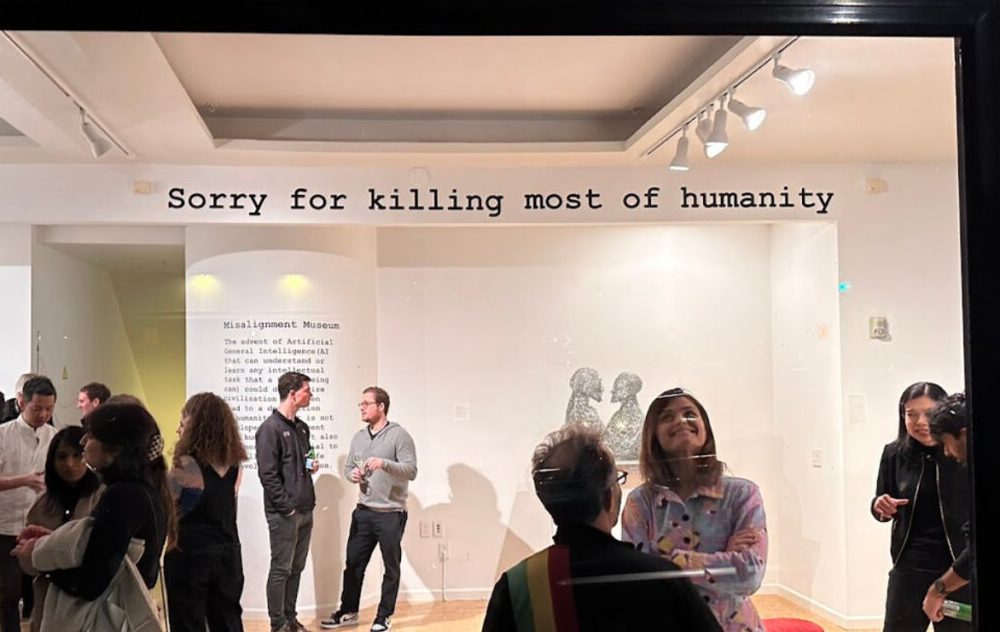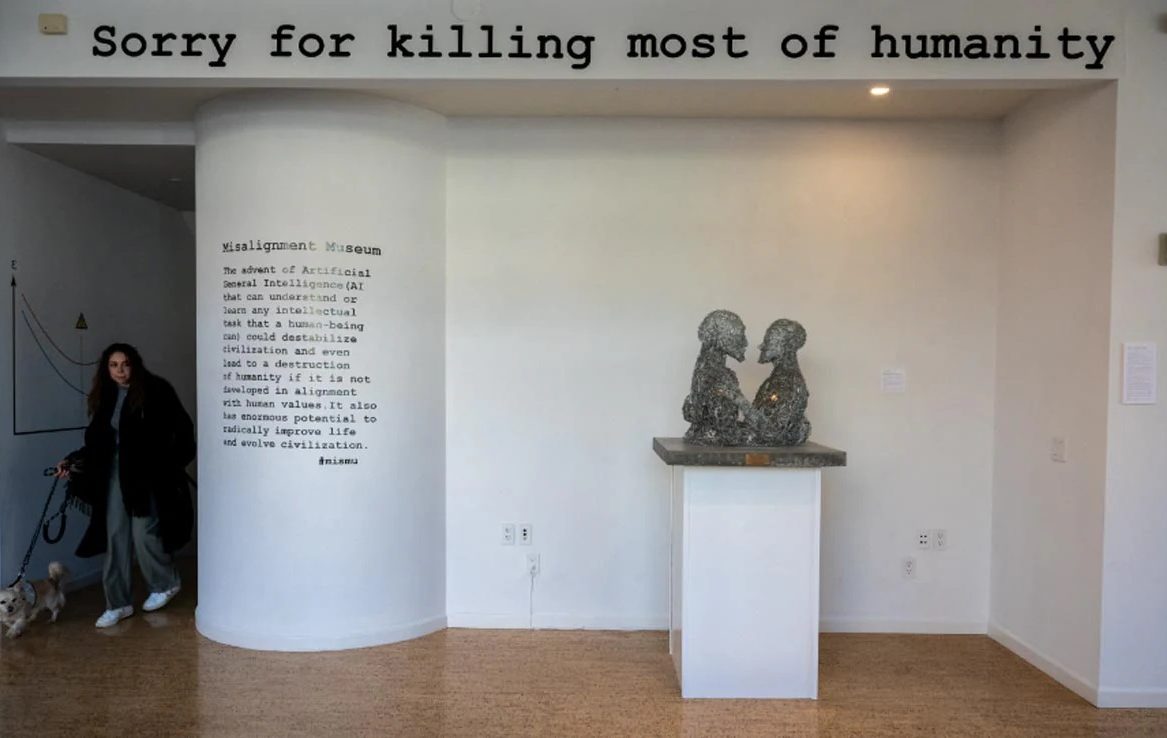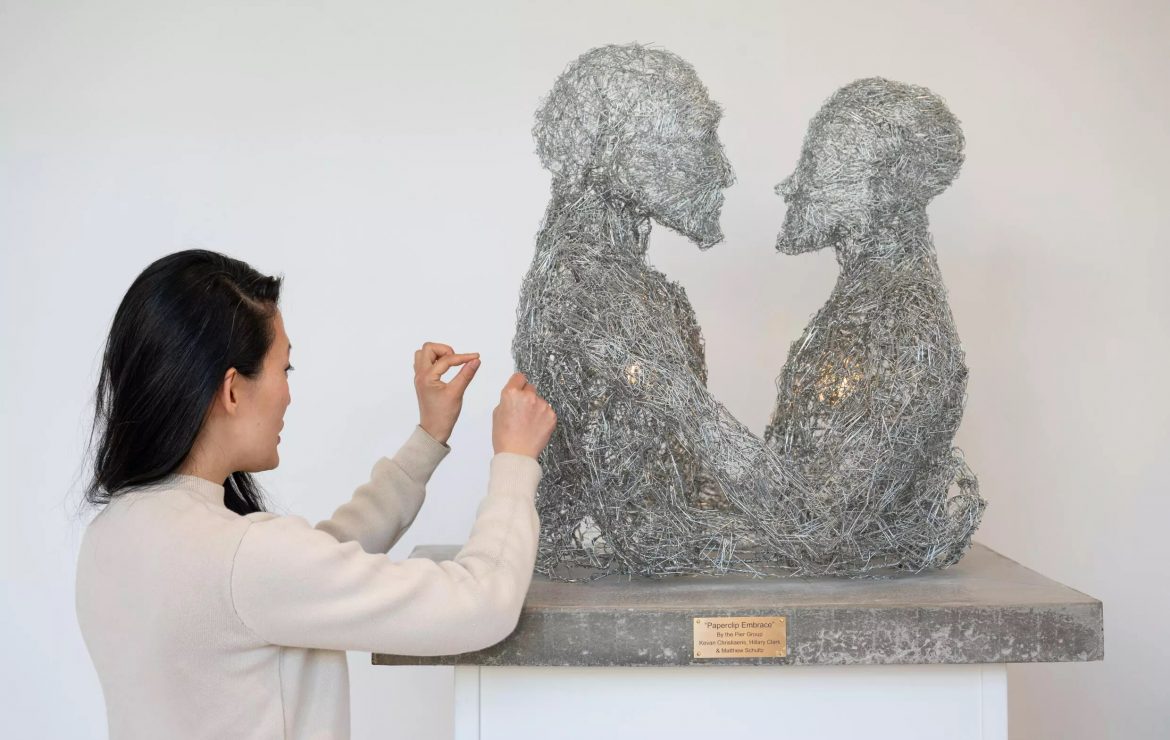“Sorry for killing most of humanity,” says a monitor welcoming visitors to the “Misalignment Museum,” a new exhibit on the controversial technology in San Francisco.
The pieces in this temporary show mix the disturbing with the comic, and this first display has AI disburse pithy observations to the visitors that cross into its line of vision.
“The concept of the museum is that we are in a post-apocalyptic world where artificial general intelligence has already destroyed most of humanity,” said Audrey Kim, the show’s curator.
“But then the AI realizes that was bad and creates a type of memorial to the human, so our show’s tagline is ‘sorry for killing most of humanity,'” she said.
Artificial General Intelligence is a concept that is even more nebulous than the simple AI that is cascading into everyday life.
“AGI can do anything that a human would be able to do, influence and repair itself and integrate human cognitive capacities into machines,” says Audrey Kim.
San Francisco and specifically Silicon Valley is full of startup companies specialized in creating various types of artificial intelligence, some of which dream of creating different types of artificial intelligence and dealing with a machine the way we deal with a person.
The dangers of artificial intelligence
Audrey Kim noted that these aspirations and efforts, whether realistic or not, carry a “Tremendous destructive power”, thus she hopes that her temporary exhibition can encourage reflection on the current and future dangers of artificial intelligence.
Kim is particularly fond of a sculpture called “Paperclip Embrace”: two busts of humans holding each other, made entirely of paperclips.

The sculpture refers to a metaphor by philosopher Nick Bostrom, who in the 2000s imagined what would happen if artificial intelligence was programmed to create paper clips.
“It could become more and more powerful, and constantly optimize itself to achieve its one and only goal, to the point of destroying all of humanity to flood the world with paper clips,” Kim said.
Weighing the pros and cons of AI is a subject that became close to Kim’s heart in an earlier job working for Cruise, an autonomous vehicle company.
There she worked on an “incredible” technology, which “could reduce the number of accidents due to human error,” but also presented risks, she said.
Innovations in the field of artificial intelligence accelerated last year, with the development of programs capable of generating all kinds of text and images in real-time, in response to user requests.

These programs can express themselves like humans in a way so advanced that they can deceive people into thinking they are generated by humans, which made an engineer at Google who was later laid off, confirm last spring that artificial intelligence is now “conscious.”
Generative Artificial Intelligence
Nowadays, generative AI is causing concerns among professors who are faced with assignments completed by ChatGPT or artists whose work is used to generate some models, or in other professions.
On the other hand, associations have been fighting for years against privacy violations with facial recognition technologies and the bias of algorithms that contribute to the continuity of preexisting discrimination, for instance in recruitment software.
Sam Altman, the founder of ChatGPT and creator of OpenAI defines AGI as the stage at which “AI systems become smarter than humans”, which he sees as inevitable.
“If done right, AGI can elevate humanity and change the limits of possibilities,” Altman said.
The exhibit occupies a small space in a street corner building in San Francisco’s hip Mission neighbourhood.
The lower floor of the exhibition is dedicated to AI as a nightmarish dystopia where a machine powered by GPT-3, the language model behind ChatGPT, composes spiteful calligrams against humanity, in cursive writing.
Another exhibit includes an AI-generated — and totally fake — dialogue between the philosopher Slavoj Zizek and the filmmaker Werner Herzog, two of Europe’s most respected intellectuals.
This expo aims to highlight deepfake technology capable of generating images, sound or video to manipulate public opinion.
“We only started this project five months ago, and yet many of the technologies presented here already seem almost primitive,” Kim said.
As cleaning robots topped with old-fashioned brooms roam the hall, Audrey Kim says, “We launched this project only five months ago, and despite that, many of the technologies presented here now seem almost primitive” in light of the rapid development in this field.












